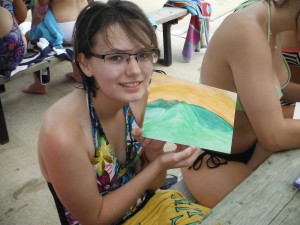Here’s to the kids who are different,
the kids who don’t always get A’s.
The kids who have ears twice the size of their peers,
and noses that go on for days.
I recently ran a weekend camp for girls in 3rd-5th grade, and it was fascinating and disturbing to hear some of them relate stories about being seen as quirky. These were “normal” girls who weren’t being judged for traditional, obvious reasons like skin color, ethnicity, or disabilities; it was for more subtle causes. The troubling part was how it was starting to affect their friendships and confidence.
Jaine had been labeled as gifted since kindergarten, and now in 5th grade she spends one full day a week at the “gifted center” with other exceptional students in her district. Jaine has always felt more comfortable talking with older kids and adults, kind of like many only children feel. She takes her schoolwork seriously and hates the petty dramas that play out amongst her peers. And so she feels left out and alone a lot.
Here’s to the kids who are different, 
the kids they call crazy or dumb.
The kids who don’t fit, with the guts and the grit,
who dance to a different drum.
Tess considers herself an artist; she loves to paint and draw and put all kinds of scraps together to make sculptures. She is a keen observer who sees the world a bit different than her peers. Tess has a high level sense of humor and is a fascinating conversationalist. She too hates how immature girls in her class act, and usually spends her time with one close friend.
Mia loves pokeyman and comics and video games. She connects better with the guys in her class who share her interests. This has put her at odds with the girls in her class, who are jealous of her relationship with the guys and who constantly taunt her with “boyfriend” remarks.
We called Molly “Little Gandhi” all weekend because of how deep, sensitive, and soulful she was. She stays out of the gossip and drama that is rampant in her school, and this puts her out of the loop with most of the girls. This angel spends many recesses alone or helping teachers in the classroom.
The weekend away from all the friend drama was a breath of fresh air for these girls, and they melted into our nonjudgmental, accepting environment. Every girl needs to be appreciated for what she brings to her class, friendships, and the world. That is the value of having ”circle time” for girls to get real, honest, and vulnerable with each other. Sharing their story and hearing how many other girls can relate to it and to their feelings is so healing. Once girls put aside superficial judgments, they discover how much more they have in common than differences.
Here’s to the kids who are different,
the kids with a mischievous streak.
For when they have grown, as history has shown,
it’s their difference that makes them unique. Digby Wolfe
Many eminent women who have made a difference in the world, women like Eleanor Roosevelt, Madame Curie, Margaret Meade, and Georgia O’Keeffe, also were considered quirky kids who didn’t quite fit the mold. They spent time in childhood developing their talents, emerging from adolescence with confidence in their abilities. They found more friends who could relate with them as they got into later high school and beyond, as peers caught up with their level of maturity. I believe that will hold true for the girls I met at my camp as well.
But we can do better than that. Provide spaces in the classroom and outside of school for girls to share their stories and connect at deeper levels so they can develop close connections and self-confidence right from the start. Adults love these kids. Let’s make sure they are appreciated for who they are by their peers as well.